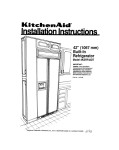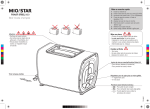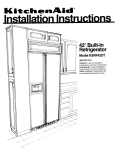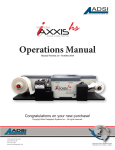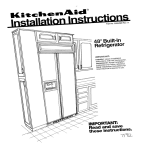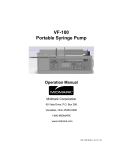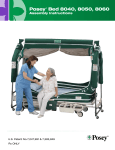Download KitchenAid KSRF36DT Refrigerator User Manual
Transcript
Before you start... Proper installation is your responsibility. Make sure you have everything necessary for correct installation. It is the responsibility of the installer to comply with the installation specifications provided. The built-in refrigerator weighs over 400 pounds. The floor must be sturdy enough to support this weight plus the additional weight of door panels, food and ice. Grounded electrical outlet is required. See Electrical requirements. l l Personal Injury Hazard Because of the weight and size of the built-in refrigerator, two or more people are needed to move and safely install it. Most of the refrigerator’s weight is at the top. Extra care is needed when moving the refrigerator to prevent tipping. Failure to do so could result in personal injury Location of the built-in refrigerator must permit the doors to open to at least 900. Because of the weight and size of the built-in refrigerator, two or more people are needed to move and safely install it. Dimensions that are shown must be used. Given dimensions required 0” clearance. provide One inch of space is required between side of refrigerator and a corner wall to allow the door to open to at least a 900 angle. NOTE: It is the customer’s responsibility: l l To contact a qualified electrical installer. To assure that electrical installation is adequate and in conformance with National Electrical Code, ANSVNFPA #70-l 987 (or to latest) and local codes and ordinances. Electrical Shock Hazard Special care must be taken when drilling holes into the wall of the house. Electrical wires may be concealed behind wall covering. Page 1 Floor Damage Keep cardboard shipping piece or plywood under refrigerator until it is installed in operating position. Failure to do so may cause damage to floor covering. Parts supplied for installation: top grille assembly base grille lube assembly misc. parts bag ice-maker bin assembly Remove parts from packages. Check that all parts were included. Parts that must be ordered separately or custom-made: Acrylic door panel kits Three colors of acrylic door panel kits are available from your KitchenAid dealer: White, Black and Almond. Each kit includes door panels, top grille panels and handle inserts. Follow kit instructions to install panels and inserts. Kit Numbers for Acrylic Panels tj Important: Observe all governing codes and ordinances. Failure to meet codes and ordinances could lead to fire or electrical shock hazard. Custom door panels, handle inserts and top grille panels Tools and materials needed for installation: Check with your builder or installer to see if you need side panels that match your kitchen cabinets. Side panels must be custom-made. Side panel dimensions are given on page 5. Phillips screwdriver 5/16”and 314” socket and ratchet 114” copper tubing tubing cutter appliance doily l/8” Alien wrench adjustable wrench cardboard or plywood 6, #6, or larger wood screws 2, wood boards 32” long (See page 7 for specifications.) 1 - 316” open wrench front leveler stepladder wrench set knife 3116” and 114” drill bits drill screwdriver level bucket shutoff valve stud locator 114” nut driver See page 4 for custom panel dimensions and page 9, steps 9 -13 for installation. Side panels Dimensions for built-in area Eieclricai outlet should be installed within shaded area, 1 Gr ‘ouhded electrich +tllet location Width and depth of the built-in area are determined by the type of installation. The built-in refrigerator can be installed with the doors flush with the wall, with the doors protruding from the wall, or with side panels enclosing refrigerator. Select one method of installation and use the dimensions given for that method as shown. Wall plumbing location Height of built-in area can range from a minimum of 82-l/2” to 84-3/4”. Optional top grilles may be required for enclosures less than 83-518”. Height dimensions with optional top grilles are given on page 3. r Hole for plumbing can be cut anywhere wilhin shaded areas. Floor plumbing location +/- 118” tolerance Page 2 Product dimensions Levelers extended l/8” below rollers er.. ta wlatn u- top of housing lo top of grille 118” min. -with 7-W grille l-118” max. -with 8-113” nrille ” -....- \ 36” width 14 710” \ 23-l/8” 4 \ - / -‘-r I 23 710” 4 Height dimensions when the minimum extension of levelers p;~:“,“,;;il&r~b”v’e’) a-, recessed height the weight the rollers: from 83.5/8” height with E-12" grille’ 83-l/8” height with 8” grille 82”516” height with 7-l/2” grille Levelers fully extended l-1/4” below rollers 1 *Top grille The 8-l/2” top grille is provided. Smaller top grilles must be ordered from your KitchenAid dealer. Check the chart below for the part numbers you need to order for the size of top grille you need. I -=I 63-518” recessed height Optional Top Grilles 1 I Height dimensions when the maximum extension of levelers (l-114” below rollers) is used to remove the weight from the rollers: 84-314” height with 8-l/2” grille’ , Size Part Number Description 7-112” 4210546 p$h;izt;;im ; 84.114” height with 8” grille Decorative panel side frame Air vane 2 1 63-314” height with 7-l/2” grille 8” Page 3 4210545 Right side trim Left side trim Decorative panel side frame Air vane Quantity : 2 1 II I Custom door panels, handle inserts and top grille panels Door and top grille Dimensions shown edges. Routing is are more than l/4” Freezer + panels: are with routed required if panels thick. Refrigerafot Panel routing and top grille door panel for door panels. I L -I *l/4” max. f door panels 5/l 6”mln. 14-1/4”-d access 34. If custom door panels greater than l/4” thick are used, il may be necessary to route the handle side of panel a minimum of 3 inches in from the panel edge lo provide a 2” minimum access to the door handle. Either the full length of the panel or a selected area(s) can be routed. Check with your builder. 6” Maximum weight of custom panel is 50 pounds. Maximum weight of custom panels is 30 pounds. Door handle inserts Top grille panels. Panel for 8-112” top grille 68-1116” Panel for Panel for 7-112” top grille + v F7/8” wide 114” thick Ill Maximum weight of custom All dimensions +I- l/16” tolerance Note: If a routed panel is used, add l/16” to all dimensions shown. panel is 10 pounds. i’ Side panel requirements +I- l/8” tolerance - t I 36”p--35-5/15”-d 4 5/32”+ 23-116” depth protruding door inslallafion I 23-716” depth flush door installation C I -2 > T 118” spacer thickness* <’ 1 I 3-314” Kb -I -m t side TV t/ doors Side trim Refrigerator when 25” depth is available. If less than 25” depth is available, go to step 3. spacers If side panel is not inserted into side trim, drill six equally-spaced holes in each side trim. Do Not drill into side of cabinet. Attach side panels to L side trim using six screws on each side. One method is to attach side panel to outside of side trim. However, this will increase width required. Drill holes into side trim. Attach a wood support to side trim. Attach side panel to panel support nailer and wood support. Cover wood support with a panel piece to match side panel. Y’ 1. Attach three spacers as shown to the top, middle and bottom of each side of the refrigerator. Spacers are required for ventilation. side panel support nailer . Side panel thickness should be l/ 2” minimum to prevent “blousing” or warping. \ l side panel support side + panel nailer spacer z wood support. + side trim if 2. A side panel support nailer should be attached to the rear wall on each side of refrigerator notches for door hinges 112” side panel recommended c Page 5 I 3. If less than 25” depth is available, side panel installation will need to be completed according to each site’s restrictions. toe panel recess 4. Height of side panels depends on your installation site. Side panels may need to be notched to clear door hinges. Side panels may be cut to match toe panel recess if desired. Notch side panel only after the installed height of the refrigerator has been determined. Water supply requirements Electrical requirements Use only l/4” copper tubing for water line. l l Electrical Shock Hazard Improper connection of the equipment-grounding conductor can result in a risk of electrical shock. Check with a qualified electrician or service technician if you are in doubt as to whether the appliance is properly grounded. An extension cord should not be used with this appliance. Such use may result in a fire, electrical shock, or other personal injury. A 120 volt, 60 Hz, AC only, 15 or 20 ampere fused electrical supply is required. A time-delay fuse or circuit breaker is recommended. It is recommended that a separate circuit serving only this appliance be provided. Recommended met hod grounding DO NOT, UNDER ANY CIRCUMSTANCES, REMOVE THE POWER SUPPLY CORD GROUNDING PRONG. For your personal safety, this appliance must be grounded. This appliance is equipped with a power supply cord having a 3-prong grounding plug. To minimize possible shock hazard, the cord must be plugged into a mating 3-prong, grounding-type wall receptacle, grounded in accordance with the National Electrical Code, ANSVNFPA 70-1987 (or to latest) and local codes and ordinances. See Figure 1. If a mating wall receptacle is not available, it is the personal responsibility and obligation of the customer to have a properly grounded, 3-prong wall receptacle installed by a qualified electrician. 3-prong grounding type wall receptacle The water line to the refrigerator must provide 15-l 00 psi water pressure. The preferred method of installing the plumbing to the refrigerator is through the wall. An optional method is installing the water line through a floor opening. If the copper tubing is installed through the floor, the hole cut in the floor must be angled 45O toward the front. You will need enough l/4”- copper tubing to connect from water line to refrigerator, a saddle-type valve and a union. Rough in the water line before installing the refrigerator. See steps that follow. 3. Ground electric drill or use a hand drill. Drill a 3/l 6” hole in vertical cold water line. Attach a saddle valve to the water line with a clamp in an easily accessible location. Insert a washer between clamp and line. Check that inlet end is solidly in the drill hole. Tighten packing nut. Tighten the pipe clamp screws evenly so washer makes a watertight connection. Do Not over-tighten or copper tubing could be crushed. 4. Slide compression nut and sleeve on copper tubing. Insert end of copper tubing completely into the outlet valve. Tighten compression nut to outlet with an adjustable wrench. Do Not overtighten. Turn on main water supply and flush copper tubing. Turn the new water line valve to the “OFF” position. 5. Route copper tubing to the refrigerator location. Product/Property Damage Hazard Do Not install copper tubing in an area where temperatures drop below freezing. To do so may result in water damage. 1 .Find a 3/8” to 1” vertical cold 6. Slrde compression nut and sleeve over water line. 7. Connect union to compression nut and sleeve. Tighten with adjustable wrench. Do Not overtighten. water line near the refrigerator. Measure the distance from the cold water line to the refrigerator location. Add 24 inches for the final length of copper tubing you will need. Cut both ends of copper tubing-square. Z-Turn off main water supply and clear water line. Electric Shock Hazard. Electric drill must be grounded to prevent severe or lethal shock if water is in line and enters drill during use. Failure to ground drill may I result in personal injury. retainer Page 6 Product support wood /block(s) A solid soffit or a wood block is required to prevent the refrigerator from tipping forward after it is installed. An anti-tip bracket is located at the top, center rear of the refrigerator. Important: Block(s) must extend to fully cover top of antl-tip bracket. -anti-tlp bracket Determine what height the refrigerator will be when it is installed to fit opening. Determine the height of the anti-tip bracket at the final installed height you plan to use. Block(s) must extend to here. Personal Injury/Property Damage Hazard The solid soffit must be no more than 1” above the anti-tip bracket or you will need to attach a wood block to the wall. soffit (more than 1” above anti-lip bracket) Failure to attach wood blocks to the wall could result in personal injury or property damage. , wood = l/4” max. Your installation location may vary from the examples shown. However, you must support the refrigerator with a wood block or other adequate means of support located l/4” above the anti-tip bracket. \ Locate wood blocks a maximum of l/4” above locate wall studs in the refrigerator opening. Center one wood block and use wood screws to attach the wood block to the wall studs. Make sure screws engage wall studs a minimum of l-112”. Screw the second wood block to the front of the first block. The wood blocks must extend 2 inches beyond the ends of the anti-tip bracket. Page 7 -anti-tip bracket anti-lip bracket \ 2 x When a soffit is not available, block(s) soffit(less than 1” above anti-lip bracket) rear wall rear wall w, If soffit is more than one inch above anti-tip bracket, locate wall If soffit is less than one inch above anti-tip bracket, a wood studs in the refrigerator opening. Center one wood block and use wood screws to attach the wood block to the wall studs. Make sure screws engage wall studs a minimum of l-1/2”. Screw the second wood block to the front of the first block. The wood blocks must extend 2 inches beyond the ends of the anti-tip bracket. support is not needed. Now start... Remove top grille assembly . package, literature package and parts bag taped to the refrigerator door and save. El El Remove the four brackets (2 on each side) that attach ’ shipping base to the bottom of the refrigerator. Discard brackets and shipping base. Do Not remove tape and door bracing at this time. Floor Damage Keep cardboard shipping piece or plywood under refrigerator until it is installed in operating position. Failure to do so may cause damage to floor covering. 14 Move refrigerator to kitchen. Place cardboard n or plywood under refrigerator. Remove appliance dolly. Open doors and remove all boxes, parts packages and packing materials from inside refrigerator and freezer compartments. Set aside until needed during installation. Do Not remove any protective film until refrigerator is completely installed. 5. 13. 14. 8. Place appliance dolly under the side of the refrigerator. Wrap strap from truck loosely around refrigerator. Insert two corner posts around handles to prevent scratching. Tighten strap making sure that handles will be protected. l l 15. 8. Personal Injury Hazard Because of the weight and size of the built-in refrigerator, two or more people are needed to move and safely install it. Most of the refrigerator’s weight is at the top. Extra care is needed when moving the refrigerator to prevent tipping. Failure to do so could result in personal injury. Numbers correspond to steps Page 8 ‘g%ndbg plug power supply cord 15.1 Move refrigerator close to final position. Remove cardboard or plywood from under refrigerator. Plug electrical cord into the grounded outlet. Use the screw from the parts package to install the plug retainer. Move the refrigerator evenly and straight into the opening. Check that the water line will not be kinked. Check that slack in the electrical cord hangs freely behind refrigerator. leveling rods clockwise using a 5/l 6” socket and ratchet until the cabinet weight is supported by the rear legs. Use l-3/8” open end wrench to lower the front leveling legs until the weight of the cabinet is supported by legs. P-I If side panels are not used, go to Step 10. Read Side panel requirements, page 5, before attaching side panels to refrigerator. ’ 16 . Check that the power switch at the too of the cabinet is in the “OFF” position. Connect the fitting to the refrigerator water valve. Do Not overtighten. (If necessary, the water valve can be removed from the underside of the cabinet to attach the fitting. You may have to remove the wiring channel to get to the valve. Remove the screw between the coils of the water valve. Remove the disconnected water valve and attach the fitting. Replace the water valve.) Slide compression nut and sleeve on tubing with fitting for water valve. Connect the union from the water supply line to the compression nut on the tubing from the water valve. Tighten with an adjustable wrench. Do Not over-tighten. Turn the water supply valve to the open position. Turn the refrigerator switch to the “ON” position. Check all connections for leaks. Page 9 / Open both doors. Place a level against the underside . of the door trim at the top of the refrigerator. Adjust the front leveling legs until level and to the right height for the recessed area. Place the level on the crisper guide in the refrigerator section to check for levelness front to back. Turn the right, rear leveling rod until level and to the required height. Place the level on the freezer basket guide to level the left side of the cabinet. 18 Remove all tape and door bracina from refrigerator door. Remoie the six screws that attach the handle to the door frame. Slide the refrigerator door panel into door frame. If the panel is less than l/4” thick, a filler panel will need to be installed between the door and decorative panel. If the decorative panel is more than l/4” thick, it will have to be routed to have a l/4” edge on all sides. See Custom panel and insert dimensions for exact sizes to cut custom panels. D-l If you wish to change the door handle insert, slide insert trim into handle. See Custom panel and insert dimensions for exact sizes to cut custom inserts. Insert end caps into each end of door handle. Replace refrigerator door handle. (Some end caps are attached with screws.) . top grille is aligned with top trim on cabinet. Use ten screws to tighten top grille frame to refrigerator. Check that the power switch is in the “ON” position. Attach top grille decorative panel assembly to the keyhole bracket on the frame and pull down to secure. If the top grille decorative panel does not fit evenly within frame, the keyhole bracket can be moved side to side by adjusting the bracket screws, or the decorative panel bracket can be moved up or down by adjusting the decorator panel bracket nuts. 1171 Open both doors. Use two screws to attach n bottom arille to cabinet Loosen the four height adjustment screws. Adjust the bottom grille to fill the space from the floor to the bottom of the cabinet. Tighten adjustment screws. 112 Repeat Steps 10 and 11 m for the freezer door. set screws Put shelves and bins into the refrigerator and freezer compartments. Remove protective film from door frame. , 119 Personal injury Hazard 113 Remove two nuts from one end of the top panel W frame. Remove end piece. Slide decorative panel into panel frame. Replace end piece using nuts. Attach the two braces to the refrigerator cabinet. Attach top grille frame to braces. Check that Reinstall set screws after door swing is set. Failure to so could result in personal injury. Check that doors can open freely. If not, the door stops can be adjusted. Loosen set screw in top and bottom hinges with Allen wrench. Determine the door swing desired. Hold door in that position and tighten the set screws. The doors have stops at 90°, 115O and 137O positions. If the door stops cannot be adjusted to clear countertops, the countertops may need to be mitered. (Consult your builder to adjust countertops.) B-l Check the water connections at the bottom of the refrigerator again for leaking. Any leaking can cause refrigerator and floor damage. . I Move the ice maker arm into the down position. n Set refrigerator and freezer compartment controls to the midpoint between “COLD” and “COLDEST”. Check that the compressor is operating properly. Check that all five interior lights and one exterior light above dispenser area are working. 120 Use a drinking glass to press ice dispenser bar. You should hear the motor and auger operating. Press the glass against the water dispenser bar. Dispense and discard 2 to 3 quarts of water to remove air from system and rinse tank. n To get the most efficient use from your new built-in refrigerator, read your KitchenAid’ Use and Care Guide. Keep Installation Instructions and Guide close to built-in refrigerator for easy reference. Page 10 / . If built-in refrigerator does not operate... Check that the circuit breaker is not tripped or fuses blown. Check that power supply cord is plugged into wall receptacle. A more detailed troubleshooting checklist is provided in the Use and Care Guide. Part No. 1113200 0 1988 KitchenAid If you need assistance... When you call, you will need the built-in refrigerator model number and serial number. Both numbers can be found on the serial/rating plate located on the frame of the cabinet. Prepared by KitchenAid@, St. Joseph, Michigan 49085 How to arrange for service... l First call your dealer or repair service he recommends. 9 All service should be handled locally by the dealer from whom you purchased the unit or an authorized KitchenAid@servicing outlet. If your local service is unsatisfactory, contact the Customer Relations Department, KitchenAid, Inc., P.O. Box 558, St. Joseph, Ml 49085.0558. Call Toll Free 800-422-l 230. Printed in U.S.A.












